|
Ford
|
1903
- |
Country: |
 |
|
Henry Ford was a product of the pioneering spirit which infected most families in the period shortly after the American Civil War. The whole country lay before them and, with faith and work, a man could weave miracles. Henry Ford was born in 1863 and by the age of thirteen he had already shown his fascination for working with his hands by fashioning a screwdriver out of a nail and had even, it is said, repaired his uncle's watch.
The Fords were a farming family, but Henry wanted to be involved with machines and at an early age headed off for Detroit's satanic mills. He was gifted, and life looked good, but his father persuaded him to come back to the farm with the promise of land of his own. So engineering was put behind him as he married and settled down to work back on the farm.
Frank and Charles Duryea
Meanwhile, thousands of miles away, Dr Otto had long since patented his engine and the fledgling motor industry was emerging in Europe. Word reached America where the Duryea brothers, Frank and Charles, sat down and designed their own car, a single-cylinder Duryea which was to run for the first time on 22 September 1893 in Springfield, Massachusetts.
The Otto engine, however, had been noticed by Henry Ford, and he made a special trip to Detroit to see the stationary Otto engine on show in an exhibition. The light, quite literally, flashed in his mind, as he realised that he had to know more about electricity. He gave up the farm and set off for Detroit and a job with the Edison Illuminating Company; he was twenty-seven years old, a significant age in Ford history.
The motor car fascinated him. Three years later he made his own engine out of an old piece of gas piping. The story is told of Henry carrying his contraption into the kitchen on Christmas Eve 1893 and setting it up in the sink, making a primitive electric ignition by connecting a wire to the electric light and getting his wife Clara to trickle petrol into the pipe. And the engine fired. It was to be three more years before he built his first car, the quadricycle, a primitive box-like vehicle devoid of such luxuries as brakes or any method of reversing save by pushing.
The Detroit Automobile Company
In the true tradition of motoring genius, he had to take the door off the toolshed to get it out, but it worked and, what is more, he sold it for 200 dollars to a friend. From then on, Henry Ford's dream slowly became a reality. He built another car and this time he had perfected it to the extent that he gathered around him some friends who launched a company - the Detroit Automobile Company - to produce it. This persuaded Ford to leave his job with Edison and become a car builder. While history would judge the decision of Henry to take on the construction of the automobile to be the right one, at the time the public were not quite ready for the horseless carriage, and the Detroit Automobile Company died.
Henry Ford was by now 38 years old with a wife and family and, in one of those twists that come only in a movie plot, he made the rather odd decision to go into motor racing. By today's standards he might be considered too old for motor racing, but Henry Ford had courage and ability. One of his partners was Childe Harold Wills, who was one of many people to prosper by helping Henry Ford on his way. Wills was a gifted engineer and later in life he was to receive a percentage of the Ford profits. The racing car Henry Ford built had two cylinders of massive dimensions and it lined up on 10 October 1901 at a dirt race track in Detroit for its first race. It was not much of a race, however, as the only other competitor was another fledgling motor manufacturer called Winton.
Winton led for the opening laps, but Ford took over and won the race, confessing afterwards to have been scared to death throughout. Oliver Barthel, one of Ford's engineers, claimed to have driven the car at over 72 mph when testing outside Detroit in July of that year.
The land-speed record at that time was held officially by Jenatzy in the legendary Jamais Contente at 65.79 mph. Alas, there were no official observers of this but it was obvious that Ford had an engine of great potential and worthy of backing. History is sketchy concerning the Henry Ford Company, which was in existence at that time and backed by various businessmen, but what is clear is that Henry Ford himself was not happy, eventually resigning from the company in 1902.
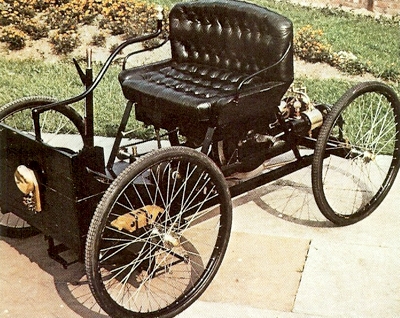 The first vehicle built by Henry Ford I, a four-wheeler with tiller steering and a two-cylinder engine powering the car to a top speed of 25 miles per hour.
The first vehicle built by Henry Ford I, a four-wheeler with tiller steering and a two-cylinder engine powering the car to a top speed of 25 miles per hour.
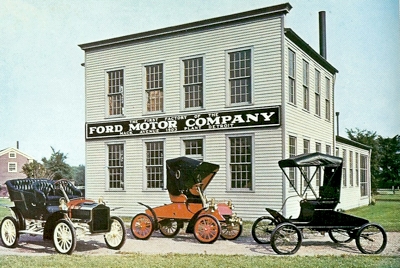 This is the original Ford Factory in Detroit, built in 1903.
This is the original Ford Factory in Detroit, built in 1903.
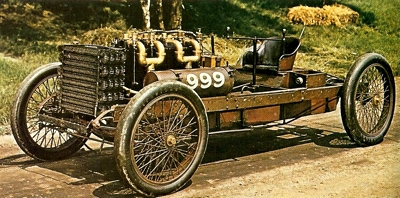 Henry Ford I and his friend Tom Cooper built 999, one of the most famous Ford racers of all time.
Henry Ford I and his friend Tom Cooper built 999, one of the most famous Ford racers of all time.
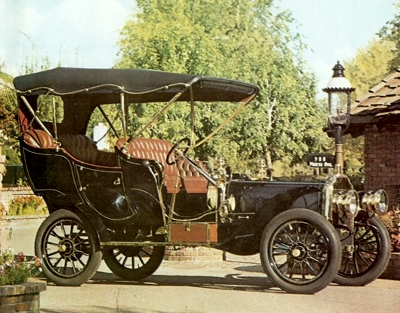 1906 Ford Model K, which was powered by a six-cylinder 6 liter engine and sold for $2500.
1906 Ford Model K, which was powered by a six-cylinder 6 liter engine and sold for $2500.
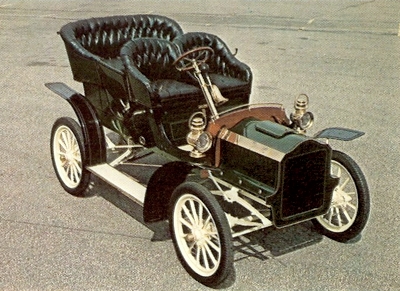 1905 Ford Model F.
1905 Ford Model F.
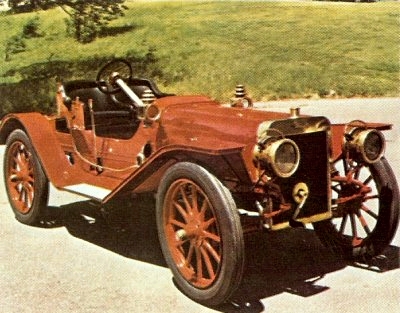 1906 Ford Model K roadster version.
1906 Ford Model K roadster version.
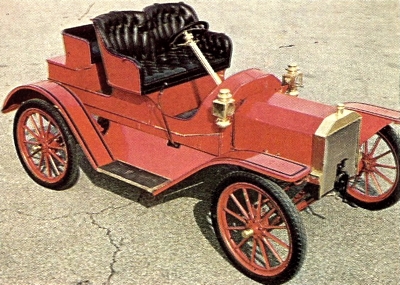 1908 Ford Model S.
1908 Ford Model S.
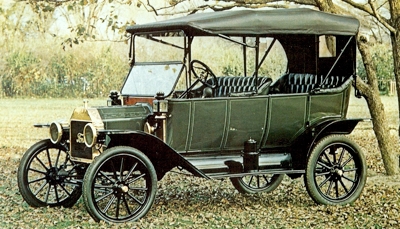 The Ford Model T, introduced in 1908 and discontinued in 1927, after more than 15 million had been manufactured.
The Ford Model T, introduced in 1908 and discontinued in 1927, after more than 15 million had been manufactured.
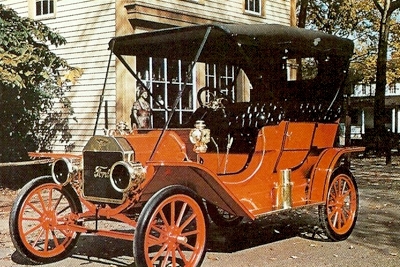 1909 version of the Model T.
1909 version of the Model T.
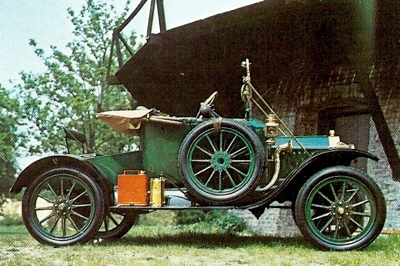 1911 Ford Model T 2-Seater Runabout.
1911 Ford Model T 2-Seater Runabout.
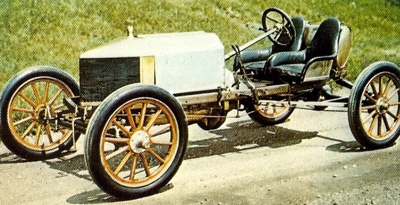 1910 Ford 999 II racer.
1910 Ford 999 II racer.
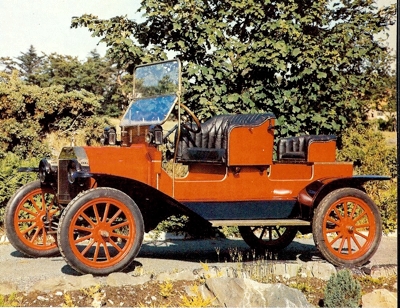 1913 Ford Model T.
1913 Ford Model T.
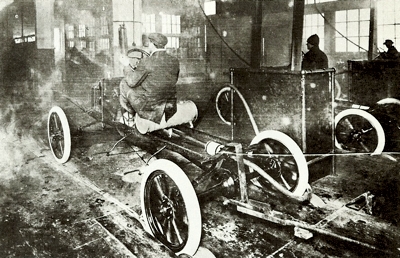 Ford Model T production line, circa 1914.
Ford Model T production line, circa 1914.
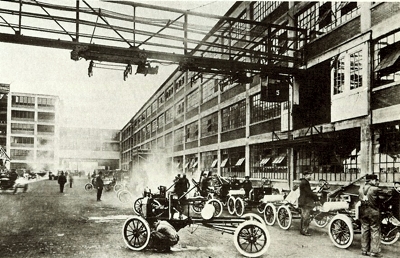 Ford Model T's undergoing testing at the Highland Park factory in 1914.
Ford Model T's undergoing testing at the Highland Park factory in 1914.
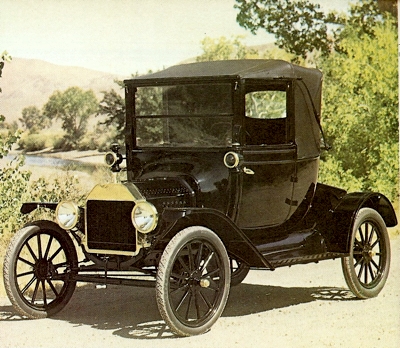 1915 Ford Model T two-seater 'Doctors Coupe'.
1915 Ford Model T two-seater 'Doctors Coupe'.
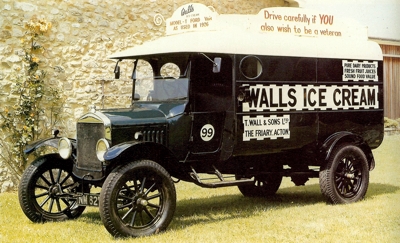 1926 Ford Model T Commercial.
1926 Ford Model T Commercial.
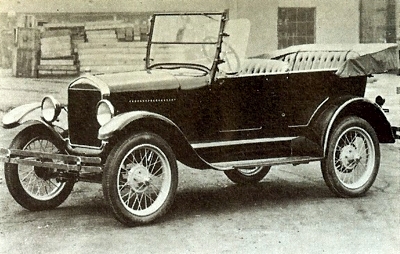 Ford's German subsidiary was founded in 1925, and in 1926 they began manufacturing the Model T.
Ford's German subsidiary was founded in 1925, and in 1926 they began manufacturing the Model T.
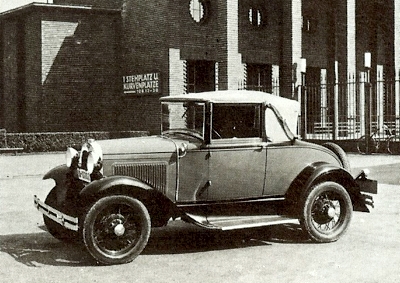
German built 1928 Model A.
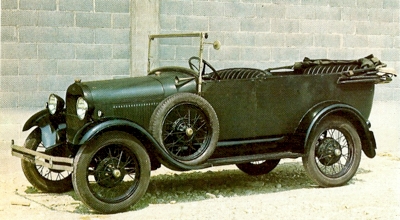
1927 Ford Model A.
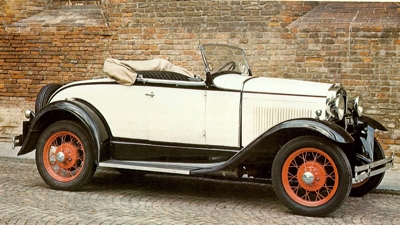
1930 Ford Model A Roadster. The Model A was a conventional 3.3 liter four-cylinder with 3 speed gearbox.
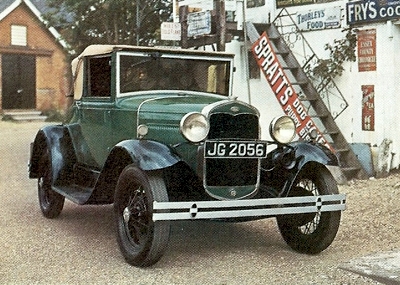
1931 Ford Model A. The 3280cc 4 cylineder engine produced 40 bhp @ 2300 rpm.
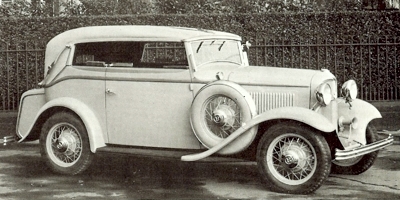
German built 1932 Ford Type 18 V8.
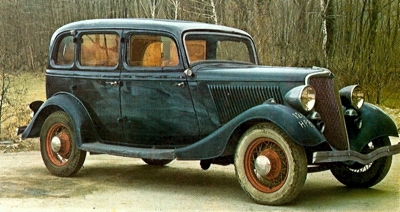
A French built 1934 Asnieres V8/40.
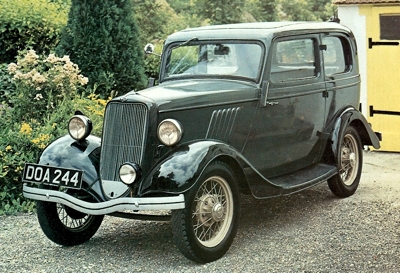
British built Ford Type Y 8 hp, the forerunner of the Popular.
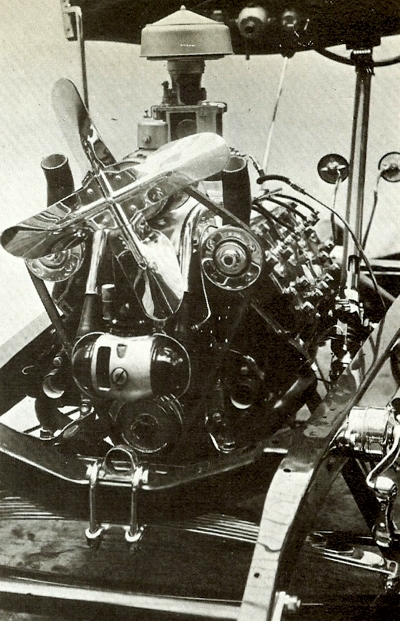
From the first mass-produced car to the first mass-produced V8 engine. Pictured is the 3.6 liter V8 which developed 65 bhp @ 3400 rpm, as seen in the chassis of a Model B.
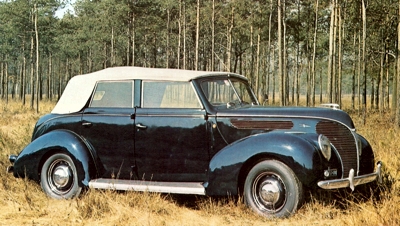
1937 Ford V8 De Luxe Five Window Club Coupe.
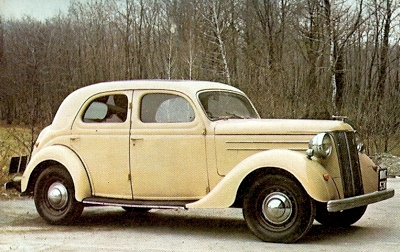
1947 Ford Pilot V8.
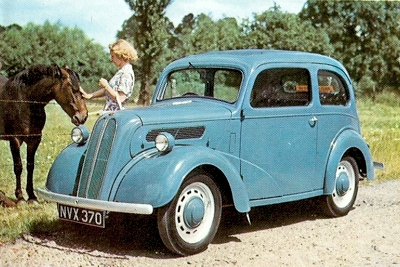
1949 Ford Anglia 8 hp.
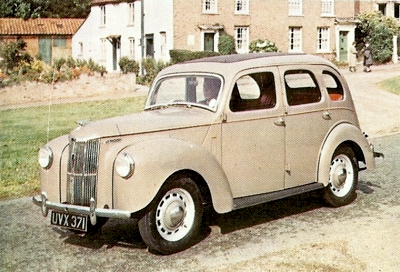
1952 Ford Prefect 10 hp.
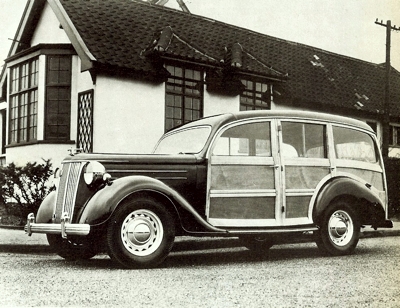
1949 Ford Pilot Woody - extremely rare.
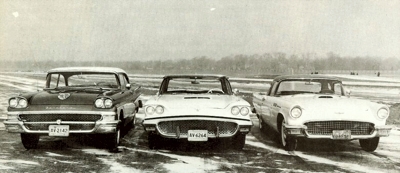
1958 Ford Fairlane and Thunderbird next to a 1957 Thunderbird.
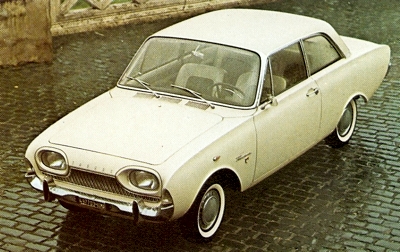
1960 German built Ford Taunus.
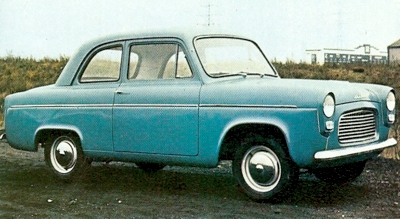
British built 1960 Ford Popular, an economy version of the Anglia and Prefect models.
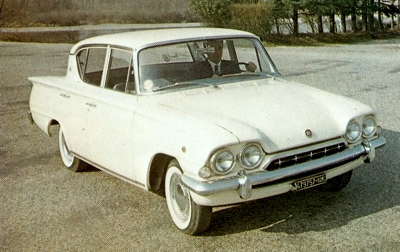
British built 1961 Ford Consul Classic 315.
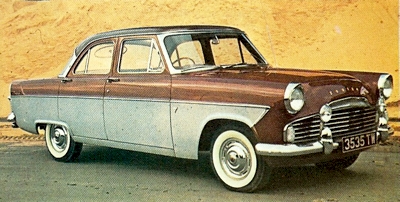
1962 Ford Zodiac Mk II. It was manufactured from 1956 to 1962.
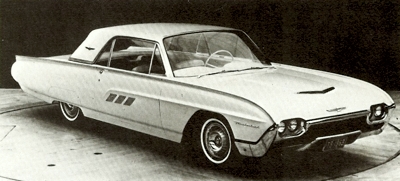
1963 Ford Thunderbird.
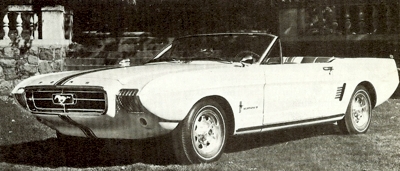
1963 Ford Mustang Prototype.
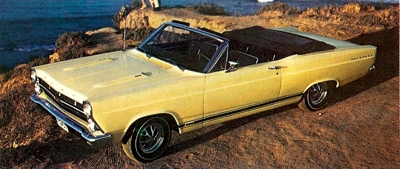
1967 Ford Fairlane GT.
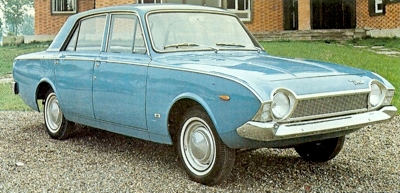
1964 Ford Corsair, built in Britain between 1964 and 1970.
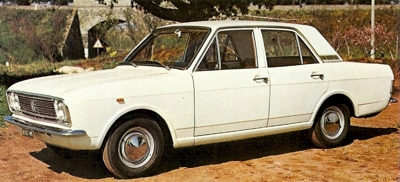
The Ford Cortina was introduced in 1963, and remained in production for well over a decade. Pictured is a 1966 Ford Cortina Mark II.
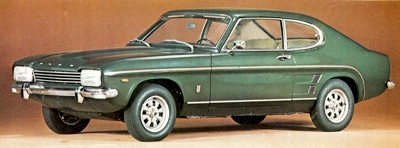
One of the most highly prized Fords outside of the USA is the Capri, particularly when in 5 liter Perana V8 guise. Pictured is the much tamer 1300cc version.
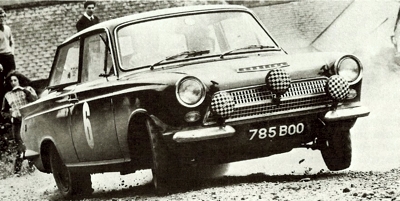
1963 Ford Cortina pictured during the Scottish Rally.
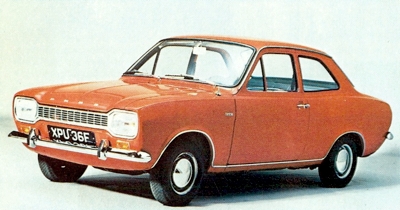
The Ford Escort first appeared in January 1968 and went on to become one of the world's best sellers. Most collectable are the RS versions.
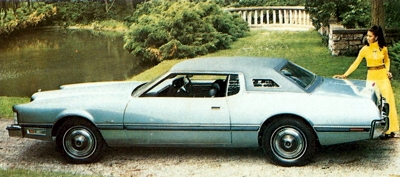
1973 Ford Thunderbird. Originally intended as a sports car, it would evolve into more of a boulevard cruiser.
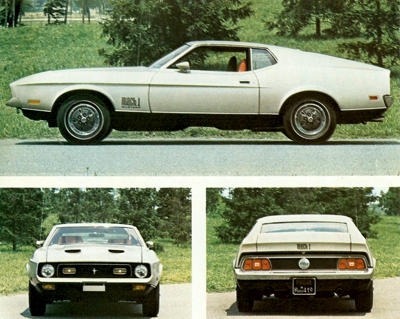
The Ford Mustang Mach 1 was available with either a 168 or 264 bhp V8 engine. After 1972, the engines would be replaced with severely detuned versions as a result of strict pollution laws.
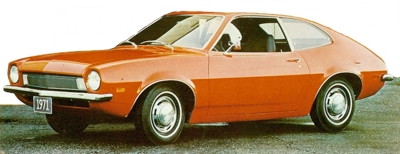
After the energy crisis of the early 1970's, Ford developed the 4-cylinder Pinto, with engine options ranging from 70 to 100 bhp. At the time, it was one of only a handful of compacts being built locally. |
The Ford 999 and Arrow
The man who took over from him was Henry M. Leland who was another gifted engineer and, incidentally, the inventor of mechanical hair clippers. The same Henry Leland changed the name of the company to the Cadillac Motor Company and later the concern was taken over by General Motors. Leland remained for a time, but eventually left and founded the Lincoln Motor Car Company, which was purchased in 1922 by Henry Ford. It was a small world in those days. Henry Ford left the Henry Ford Company with $900 dollars and the plans for two new racing cars. Along with his friend, a professional cycle racer called Tom Cooper, he set about building 999, the racing car for which he is most famous. It was named after the New York Central railway engine which had been timed at 112.5 mph.
A second car, named the Arrow, was also built. At first neither car ran as well as planned, but after some more work had been carried out Ford and Cooper called in another cycle racer to drive the cars. This man had never driven a car in his life, but was to become one of America's legendary racing drivers. His name was Barney Oldfield. The car was formidable and it was described as follows: 'Behind the giant, grease-spewing engine was a 230-pound flywheel, connected to the drive-shaft by means of a wooden-block clutch. At the other end of the shaft there was no differential, merely a Stone-Age crown wheel and pinion arrangement to send the power to the rear wheels; it was lubricated with grinding compound. There were no universal joints anywhere in the set up, all of it being bolted to the wooden frame, and to make things even more interesting there was no rear suspension.
The driver's feet were only a few inches from the exposed flywheel, and it was a rather grim proposition. It would seem the reason Oldfield went so fast right from the start was that he didn't know enough about the potential dangers to let them worry him'. The original 999 was never as fast as the Arrow but the whole matter is confused by the fact that, towards the end of that year and into the next (1903),
Barney Oldfield drove the Arrow at various times under the name of Red Devil and even 999. It was this kind of promotion which kept Ford's name in front of the public and paved the way for the foundation of the Ford Motor Company.
The Ford Motor Company Is Formed
So it was on 15 June 1903 that the Ford Motor Company was formed and, as one might expect, the shareholders were a motley collection of men each seeing in the company something slightly different. In time, this was to lead Ford into buying out all of his original backers. The key man, however, was Alexander Y. Malcolmson, who was involved in the coal industry, and he put up some money for Ford to design a car. James Couzens worked for Malcomson and became the man who dealt with the running of the company, whilst Ford was the designer and engineer.
They decided to buy in their components, and this was where the Dodge brothers came in. John and Horace Dodge were involved in the bicycle business and were good machinists. The company they formed was successful but was taken over by a Canadian firm, leaving the Dodge brothers to ponder their future. They moved to Detroit and opened up a machine shop making bits and pieces for the Olds Motor Works. Ford approached them and offered 100 shares in his company at a nominal value of 100 dollars a share in return for the Dodge Brothers' assurance that they would build the engines.
The Daisy Air Rifle Company & Charles H. Bennett
Against the advice of friends they did so and prospered. So much so that, when they were bought out by Ford a few years later, they were able to found the Dodge Motor Company. Henry Ford had proved to be a past master at raising money but this, his third venture, proved to be slightly more difficult. The Daisy Air Rifle Company was interested in a merger, but backed out when the stockholders got cold feet. However, the man who had brought Daisy and Ford together, Charles H. Bennett, the president of Daisy, maintained his faith and invested 5000 dollars.
The major shareholder was one John S. Gray, who invested $10,500 dollars. So it was that, with $28,000 dollars in cash, the Ford Motor Company was founded, and only one month later the bank balance showed just 223 dollars 65 cents. At about this time, they sold their very first car at the full price of $850 dollars. History does not record the name of the man who bought that first Ford car but he was not alone, and within a year the directors shared nearly 100,000 dollars in dividends.
From those modest beginnings the company grew to into a global giant, and by the mid 1970's they had expanded to own 67 assembly and manufacturing plants here in the United States alone and manufacturing subsidiaries in Britain, Canada, Belgium, Germany, Australia, Argentina, Brazil and Mexico - not to mention sales and assembly plants in Europe, the Middle East, South America, Malaysia, Singapore, South Africa, New Zealand and the Philippines. Apart from manufacturing cars, Ford at one time or another owned the Philco-Ford Corporation, an electronics and radio company, Ford Motor Credit Company, the American Road Insurance Company and the Ford Leasing Development Company, apart from the massive Ford Foundation.
The 'Original' Ford Model A
The first Ford production model was the Model A - some years later Henry Ford was to re-introduce the name Model A, so leading to considerable confusion. The original Model A was a simple design, in line with most cars of the turn of the century. It had two cylinders producing 8 hp and was water cooled. Its maximum speed was just short of 30 mph and, at a time before thermostats had been developed, the original Model As were said to boil when nearing their maximum speed. This was, perhaps, just as well, as the car never had a great reputation for brakes. It also had the bad habit of recoiling on the starting handle if the ignition was not fully retarded, resulting in what became known as 'Ford elbow'.
For Henry Ford these were days of great fulfilment and he would spend his time devising ways of improving the car, getting down on the shop floor, giving encouragement and advice. Although the company was successful, there were internal divergences of opinion between the engineering faction, led by Henry Ford, and the business faction led by Malcomson. There is no doubt that Henry Ford foresaw, before almost everyone else, the impact of the motor car on the ordinary man in the street, and that he saw him as his ultimate customer, rather than the wealthy who could indulge in the pastime in those early days.
To these ends he saw the need for a simple car which was inexpensive to make, and therefore could be sold in large numbers because of its low selling price. The businessmen in the company thought differently, however, and saw each individual motor car as an object of profit. They argued that the greater the profit per unit, the greater the profit at the end of the day, and they persuaded Henry Ford to make bigger cars. So it was that, before their first year was out, they were preparing to introduce the Model B Ford to sell in the $2000 dollar bracket; a lot of money in those days.
The Selden Patent Affair
In the midst of this preparation, however, there came the Selden Patent affair, something which was to dog Ford for many years before it was finally settled. George Baldwin Selden was a patent attorney and Civil War veteran who had an inventive turn of mind. Although most of his engine designs remained still-born, he did manage to produce an engine based on the Brayton principle and applied for a patent in 1879. Selden was never able to do anything about his engine as he could not find anyone to provide him with money, but on the record book Patent No. 549160 'Road Machine' existed.
Eventually he managed to sell it on a royalty basis to W. C. Whitney. Ford was taken to court by Whitney for infringement of patent as he refused to pay royalties on his engines. The problem was that when Selden had filed his original patent he had asked for a patent on the whole principle of the internal combustion engine rather than a specific design, so that every manufacturing company came into his line of fire. Alas for the industry as a whole, some of the manufacturers felt it was better to pay the royalty rather than fight the case and Packard and Cadillac, amongst others, organised their own association which duly collected 1¼% on the retail price of every car sold in the United States.
Whereas other companies bowed to Selden's bidding, Henry Ford did not and came out with one of his celebrated quotations. When asked what he was going to do about the affair, he replied: 'Selden can take his patent and go to hell with it'. So Selden sued. There followed a chapter in the development of the Ford Motor Company where work went on in the shadow of legal wranglings over the Selden Patent. In 1909, the court ruled that Selden was right and Ford was wrong, but Ford refused to back down and appealed, carrying out an advertising campaign in opposition to a Pro-Selden campaign run by the Association of Licensed Automobile Manufacturers.
It was a legal case was studied for decades to come, because on 11th January 1911 in the appeal court, the Electric Vehicle Company lost its case, on what now appears as a very simple matter of fact; namely that the patent was held valid but that it had not been infringed as the motor manufacturers were using, not the principle of the internal combustion engine which Selden had modified from Brayton, but the German principle defined by Dr Otto.
Meanwhile, the Model B had proved to be relatively unimaginative, and to a publicity-conscious Henry Ford something had to be done to lift it up a little in the public mind. His earlier attempts at speed records came back to him and he resurrected the old Arrow car, aiming to set a new world land speed record and take the title away from the French. To do this he needed a straight stretch of roadway, as the Arrow was none too good around the corners, and eventually he decided to wait until winter and use the frozen Lake St Clair for the attempt.
Spider Huff
Ford went out for the magic 100 mph and made a run on which this speed was claimed, but there were no official timekeepers present. Little is recalled today of the sheer bravery of the pioneer motorists and this particular attempt was one of the epic performances of all time. There was a two-mile run-up to the measured mile and the ice was so rough Henry Ford took with him his loyal mechanic, Spider Huff, who agreed to operate the throttle - the reason being that on the rough surface Ford could not keep his foot steady on the throttle while steering.
Contemporary photographs show the over-coated Huff draped over the top of the engine, half kneeling just behind the front wheel, and almost completely obscuring the driver's view of the track. The run itself was pure drama with the car sliding from side to side, occasionally hitting the snow banks and bucking in the air. Despite all this, it covered the mile in 39.3 seconds - an average speed of 91.37 mph. What made the whole trip even more exciting, however, was not the run itself but the fact that the course led straight into virgin snow and the car fishtailed at high speed through the snow heading for a schooner trapped in the ice.
The Model K Ford
It eventually came to rest, and Huff had to be prized loose, such was the cold. After all this, the AAA officials then had a heated argument as to whether a record set on ice would qualify as a 'land' speed record. Closely following the Model B Ford came the Model K Ford, which went two cylinders better with six in line. It was this car of which Ford is quoted as saying, 'I've got no use for a motor car that has more spark plugs than a cow has teats'. He still tried to make something of the Model K engine and again used it for a race car, but on its first run it broke its crankshaft; nevertheless, by 1906, Ford had managed to persuade the engine to produce 100 bhp.
At this time Fords were building six model Ks a day and the company was making money. This still did not satisfy Ford, however, as he dreamed about a car for the ordinary man. Indeed his dissatisfaction at some of his colleagues' lack of understanding led him into conversations with Billy Durant and what might have been one of the classic transactions in motoring history. Durant had taken over a company started by a Scot named Buick and, like Ford, he saw that the future was in the popular car; so he approached the finance houses of the day for the backing he needed. They were sceptical about Durant's plans for the renamed International Motors Company and Durant decided to finance his own project, changing the name of the company from International to General Motors.
International Motors becomes General Motors
He too was successful and the story goes that he put out feelers about taking over Ford. Ford went to New York to discuss the deal, and it is said that he agreed to sell out to General Motors for eight million dollars. As it turned out, Durant could not find the money so the deal was off. Finally, Ford won over most of the other directors and set out on the project which was to make his name famous: the
Model T.
The Model T was launched on the 1st October 1908 after Malcomson and his friends, who had led the group in favour of bigger and more luxurious cars, had sold out to Ford and Couzens.
The Model T was introduced at around $850 dollars, and it not only gave the world transportation over the roughest roads but added a new dimension to life, like such other American institutions as Coca-Cola and the hamburger. People sang songs about it, made jokes about it, wrote books about it, married, lived and died in it.
The Model T
Tagging on to the coat-tails of its success were the accessory manufacturers who had a field day offering everything to make it look or do things that normal Model Ts did not. They made wheels which allowed it to run on railway tracks and it powered all sorts of machinery. To say that the Model T became an institution would be no exaggeration. On the same day the car was introduced, the directors voted themselves 100,000 dollars in dividends and repeated it a few months later. The money just rolled in. The dam had been breached. Motoring was here to stay.
To put the success in context: Jim Couzens's sister reluctantly bought one share in the Ford Motor Company when it was founded in 1903; by 1908, after a 20 to 1 share deal, her share had brought her 28,000 dollars in dividends. It must be remembered that the Selden patent case still hung in the air and there had been heavy advertising advising the public against buying cars from non-registered companies, of which Ford was one. It did not matter, but it made Ford more determined to settle the Selden patent row.
The company had to grow to keep up with demand and Ford opened a factory at Highland Park. In 1910, 21,000 Model Ts rolled off the production line and, by 1912, nearly 200,000 were produced in the year. By this time, even with production line methods primitive by today's standards, the orders still ran well ahead of production. It was around this time that Ford, in despair, made his oft-quoted comment that people could have any color of car so long as it was black. The fact was that there was no time to paint them any other colour, even though a Model T was now taking only a matter of minutes to manufacture on the line.
1914 saw the start of World War 1 but, for Henry Ford, success and the ever-growing profits were beginning to become embarrassing. There seems little doubt that his early farming upbringing left him with the feeling that it was better to share wealth generally, rather than to restrict it to a small number of people. One day, when looking through a pile of orders for Model Ts, he decided to take 20% off the retail price of each car and he announced a plan which was, in a way, self-generating. He put it as follows: if more than 300,000 people bought Model T Fords that year he would return 50 dollars to every person who bought a car. As it transpired, this gesture cost him 15 million dollars, as 308,000 cars were built that year.
The Five-Dollars-A-Day Wage
This was not as disastrous as it might seem since, with greater volume, production costs were lowered. By now, Ford employed 13,000 people and the company was still growing. In a typical gesture, Ford raised a storm when he decided that, instead of paying the work force at two dollars a day, he would raise this figure to five dollars a day. Needless to say, his fellow motor manufacturers and fellow industrialists in all walks of business life were horrified. There were predictions that Ford would ruin the country, and workers began to pour into Detroit; ten thousand arrived the next morning at the plant.
The effect of the five-dollars-a-day wage was considerable. It increased morale and it increased productivity. It also established a sociological department in Ford which operated ever since, and Ford had an enviable record in the area of caring for employees. Almost from this point, Henry Ford himself changed, and he became involved in many social causes during the twenties and thirties.
The Model T, in fact, changed everything. For one thing, it threw this relatively shy man into the limelight, as Henry Ford was not only a well known name in the United States but, with the Model T as his calling card, he was famous all over the world. Model Ts found themselves everywhere, on every continent, doing impossible things. Ford still lived modestly but by now he was the target of all who sought a few dollars here or a few dollars there. The begging letters came in by the sack-load and it must have been a great blow to the man who saw, in the motor car, the great equaliser and the machine that would bring peace and happiness to the world.
Business Is A Service, Not A Bonanza
Then there was the matter of the River Rouge plant which put Ford in conflict with his fellow stockholders as to financial policy. Ford foresaw continued expansion at a tremendous growth rate, and in 1919 bought a site near Dearborn on the Rouge River. However, the Dodge Brothers strongly disagreed with Ford over his expansion plans and led a band of stockholders who preferred to see dividends. Again Ford came out with an eminently quotable remark, 'Business is a service not a bonanza'.
Ford lost the case and won the war. He was ordered to pay nearly twenty million dollars in dividends. As his own personal shareholding represented eleven million of this, the blow was not so bad, but he was so disgusted with the stockholders that he reacted in a typical Ford manner. After disappearing to consider his next move, he let it be known that he was going to form a new company to build a better and cheaper car. The net effect on the stockholders was disastrous and Ford, who had anticipated this, proceeded to buy everyone out at 12,500 dollars a share.
It cost him 100 million dollars, but he was able to borrow the money, and the company, lock, stock and barrel, was owned by him and his family. In ten years, the company doubled in value; the gamble had worked. In 1919, Ford had recovered well from the war and produced 750,000 cars, one third of the total of US production and, by 1921, they had over 50% of car sales in the United States.
Edsel Bryant Ford
Edsel Bryant Ford, Henry Ford's son, was now president of the company, although the personality and character of Henry Ford still dominated the scene and appeared to keep Edsel Ford in the shadows. Where his father played hunches and was domineering, Edsel saw the importance of social changes and the pressures of the business world. It was he who suggested that the legendary Model T should be replaced by something more modern - and was snubbed for it.
In 1922, Ford was looking into a possible air-cooled engine and, although development work continued through 1925, it was a conventional water-cooled, four-cylinder car which was eventually to supplant the Model T. This was
the new Model A. The car had a high body with a flat vertical windscreen, and it was attractive in its own way. It had taken some convincing to make Henry Ford drop his beloved Model T, but the Model A was something different. It was no longer a spindly automobile, it looked robust, strong and stylish and was just what the market wanted.
The Model A's engine produced enough power to make it a faster car than its rivals and it was a success from the start. Nearly 400,000 people put down deposits within two weeks of its announcement. The last Model T to come off the line was produced in May 1927; no less than 15,007,033 had been built, a record for mass production of a single model only surpassed by Volkswagen with their Beetle. It took six months for the changeover to the Model A but it was worth the wait.
During this period the main production line was moved from Highland Park to the Rouge plant and, on 20th October 1927, the first Model A was ready - although the final transfer to the plant was not completed until eleven days later. Amongst the items which created interest in the Model A was the use of a laminated safety-glass windscreen - the first to be produced as standard equipment in the motor industry.
Where the Model T had established mass production, the Model A introduced proper assembly-line methods, with the careful weighing of piston and connecting-rod assemblies. The Model A had a four-cylinder engine with a three-bearing crankshaft made of carbon manganese steel. The pistons were of aluminum and it used chrome-silicon alloy high-duty valves. There was a three-speed gearbox, worm and peg steering, Houdaille double-acting hydraulic dampers, cable-operated four-wheel brakes, welded wire wheels and a thief-proof Electrolock ignition.
The Model A was offered with five different body styles. In I928, nearly 820,000 Model As were built and sent all over the world, and it looked as though Ford had hit the jackpot once again. At the same time, production of the Fordson tractor was closed down at the Rouge plant, where it had been made since World War 1, and moved over to the Ford factory in Eire. It is interesting that where Ford decided to build their plant in Ireland, they chose Eire rather than Ulster. Henry Ford felt that he wanted to help Eire and it is said he promised the City fathers of Cork that he would employ 2000 workers.
Due to the post-war depression of the 1920s, only 1600 were employed and there was a threat. from the authorities in Cork that they would cancel Ford's lease unless another 400 workers were engaged to honour Ford's promise. Ford's reaction to this was typical: he threatened to close the plant, stopped any further development, and laid off 500 men. Around the same time, he built plants in Denmark, France, Spain, Italy, Argentina, Brazil and Mexico.
By 1929, Ford employed 162,270 workers in the United States alone and the annual wage bill was 300 million dollars. On 4 February that year, the millionth Model A was produced, the second millionth on 24 July and on 1 December Ford raised his daily wage to seven dollars. In that year, there was a town-car version of the Model A, complete with a chauffeur's roof and costing $1200 dollars, whilst at the other end of the scale was the Model A Tudor which sold for $500 dollars and came in grey, green or black.
These were heady days for Ford, the three millionth Model A in March and an all-time high in daily production of 9656 units. Before 1930 was out, four million Model As had been produced and there were nine different models from which to choose. This following year, however, saw the first swing in the opposite direction and, although the five millionth Model A was produced in this year, the sales figures were slipping down and it was time to think of a new model again.
The Ford V8
What Henry Ford had up his sleeve was to cause a sensation. It was a V8-engined car at a very competitive price. It was not, of course, the first V8-engined car to be put on the market - the Hewitt company had produced a V8 as early as 1907 - but it was the first one for the ordinary man in the street. Ever since the failure of the Model K six-cylinder car in 1906, Henry Ford had distrusted the six-cylinder engine, so he ate his words and built the eight-cylinder.
Just to hedge his bets, however, he introduced a Model B in April 1932. In the sales league, the V8, selling at a price not much more than a Model A, soon outstripped the model B and in 1932 the company sold 298,647 V8s, compared with 133,539 Model Bs. Contemporary commentators indicate that the Model B would have been a complete flop had it not been for the fact that the company could not tool up for the V8 fast enough to meet customer demand, and the dealers were switching buyers to Model Bs. The four-cylinder Model B cost 495 dollars and the V8 just ten dollars more.
In 1933, production was speeded up and over half a million V8s were sold, but for 1934 the company were in top gear and were able to offer fourteen different models on the V8 chassis, with the Tudor the most popular. On 19 June 1934, another milestone was reached with the millionth Ford V8 and a year later they made it two million. But this period was significant for, whilst Ford were rushing ahead with the V8, their other company,
Lincoln, was going a step further and on 5th October, they introduced the twelve-cylinder Lincoln, produced at about double the price of a Ford V8.
Lincoln had been Edsel Ford's baby. He admired the beautifully made Lincolns and was determined to maintain this quality image even though his father tended to pooh-pooh the idea. The L series Lincoln of 1928 was the first of the Edsel Ford-inspired cars and it produced 90 bhp at 2800 rpm. The object of the L series was to give better reliability and it is said that the gangsters of the 1920s preferred this car as they saw in it reliable and rugged transportation that would not let them down.
At the same time the police and law enforcement agencies also plumped for Lincolns. Connoisseurs of Lincolns argue that, when Ford increased the bore of the Lincoln engine in 1928, it produced engine vibrations which were previously unheard of. These same experts, if given a choice, went for the Locke-bodied sport phaeton, a five or seven-passenger car with long, elegant lines and a comfortable cruising pace of 75 mph. The later L model Lincolns were fitted with built-in air compressors for inflating the tyres, inspection lights, leather upholstery and carpets and sold for $4200 dollars.
If you wanted class, however, the choice was a Brunn-built Cabriolet Brougham at over $7000 dollars. The new car was the
V12 KB model. This used a 65 degree V12 engine which produced an effortless 150 bhp at 2400 rpm. This and the V8-engined KA model continued, with modifications to wheelbase and engine output, right into the 1940s. They nearly all featured special bodies by companies like Brunn, Judkin, Dietrich, Willoughby and the prestigious Le Baron. There was also the famous Lincoln Zephyr of 1935, which brought to the American public the concept of the streamlined car. Although its shape was to influence American car design right into the 1950s, the original Lincoln Zephyr never sold terribly well, partly due to poor performance.
Harry Bennett
Meanwhile, the V8 was selling well, the three millionth being built around the same time as the three millionth Ford truck. From this time, right up to World War 2, Ford appeared to go from success to success, the Mercury range of cars being introduced in 1938. From the outside, Ford were riding on top of the world but behind the scenes the ageing Henry Ford was seen to be losing his grip and Harry Bennett became the key man running the show. Bennett had a most unlikely background to be heading such a company. He was an ex-fighter and did not hesitate to display his craft.
His nature contrasted greatly with the quiet and cultured Edsel Ford. Henry Ford insisted on making decisions helped by Bennett and, as Ford had a dislike of accountants, there began to appear cracks in the solid financial structure of the company. It was in this period that General Motors gained the edge on Ford. Soon after World War 1 Ford had had 60% of the market, but by the end of World War 2 General Motors had 50% and Chrysler had 20%, which illustrates the drop in Ford fortunes during the 1930s and 40s.
Some economists consider that, despite the sales of the V8, Ford made little or no real net profit in those years. The 1937 figures, for example, showed only a 1% profit on capital employed. On top of this Ford was anti trade union, which led to bitter clashes and a further erosion of confidence. By 1941, things were serious. Henry Ford had suffered a stroke and was to suffer a second one. His son Edsel was also suffering from the despair of being president of a company but with little executive decision making, and two years later he died.
Henry Ford II
The war was at its peak and Henry Ford returned to assume the presidency of the Ford Motor Company. A few months later, Henry Ford II was released from the Navy to return to the family business. During the war, Ford built many things, including bombers, but it was obvious that something had to be done to rescue the company. On 21 September 1945, Henry Ford resigned and Henry Ford II was named president of the board; he was 28 years of age, one year older than his grandfather had been when he started out. Henry Ford II did not have to seek out any problems, as the company was losing ten million dollars a month.
Ford's aim was simple: lift morale and get Ford back into its competitive position. To do this, he displayed the drive and enthusiasm which had characterised his grandfather's early days, only this time it was channelled in the direction of business efficiency. The Fords produced soon after the war were very similar to the models made in the 1940s before hostilities commenced. Edsel's last big car, the Mark I Lincoln Continental of 1940, was still being produced but there had been cosmetic changes to bring it into line with the demands of the public in 1948.
The Mark I Lincoln Continental has become something of a classic car and was selected by the Museum of Modern Art as one of eight cars chosen for their 'excellence as works of art'. In the original car, the power was too low to give the performance it deserved, yet over 5000 were built and sold up to 1948. However, when it was restyled that year, the car did not catch on with the public as the smooth wing shapes had given way to the heavy ornate chrome work that was to characterise all American cars in the early 1950s.
The Ford Foundation
Behind the workings of the company was the Ford Foundation, formed by Henry and Edsel Ford in 1936. This was set up to provide grants to charitable and educational institutions in the area around Dearborn, but in 1950 Henry Ford II was to make the Ford Foundation into an International organisation, its money coming from capital invested in various securities. It became the world's largest philanthropic organisation, with much broader aims to advance human welfare. It promoted better education and overcome social problems as well as for the development of fine arts and by the late 1960s, the Ford Foundations had given more than three billion dollars to over 5600 institutions in the United States.
Stylist George Walker
Ford's first big announcement after the war was the 1949 model, which was the first to show Henry Ford II's influence, and was the result of hiring the stylist George Walker to come up with a new look. This car, looked at today, is hardly inspiring with its narrow side windows and dumpy body, but it caught on and the dealers began to clamour for it. That year, Ford made a profit and were well on their way.
The Korean war was on the horizon but it was still detached from the American public and probably had less effect on the buying public than many people thought. Henry Ford II, despite his youth, was showing himself to be a superb organiser and he had more and more automation in mind. In 1951 there came the Victoria hardtop, while Lincoln produced a customised car called the Capri - a name which was to recur later in the history of Ford.
The Ferguson Patent
Just as Henry Ford I had had the Selsden Patent case over his head in his early years, so Henry Ford II had the Ferguson patent to worry about. During the late 1930s, Ford had used some of the ideas of Harry Ferguson, the Irish inventor, in his Fordson tractor, and there was a gentlemen's agreement to produce and distribute the Ford-Ferguson. It was decided that a new company be formed by Ford, called Dearborn Motors, to distribute the tractor and this was done in 1947.
Ferguson, however, sued the company over his patents and, after a long case, Dearborn Motors were obliged to pay him over nine million dollars in settlement. Ford then bought out Dearborn Motors from the stockholders, so accepting the liabilities. All the Ford companies were picking up after the war and launching new models.
Made In Dagenham
In Britain, Ford of Dagenham produced the Ford Prefect and Anglia with the ubiquitous Ford 1172 cc engine, much beloved of a new crowd of people who were prepared to modify it for racing and rallying. It could be said that much of the foundation of British motor sport in the early fifties was built around the square, box-like Ford Anglia.
In France, Ford France produced the Vendome which looked similar to the 1949 American Ford. It was more luxurious than the popular Vedette and used a 4-liter, V8 engine developing 95 bhp. This was the time when 'dream cars' began to appear at motor shows and in 1954 Ford produced the FX Atmos and the Lincoln Monterey XK800. This was also the year of the mergers, when Nash Kelvinator and Hudson got together to form the American Motors Corporation and Studebaker and Packard merged to form Studebaker-Packard.
In 1955, Ford and Chevrolet were running neck and neck with something short of 1½ million cars each and all the motor businesses in the United States were selling well. Wrap-round windscreens came in, tubeless tyres were being used as standard equipment and, as for colours, you could get a Ford in almost any color so long as it was not black.
The Ford Thunderbird
One of the results of a market survey which had been carried out on Henry Ford's instructions was the planning of what would be termed a sports car. Chevrolet had introduced the Corvette so Ford countered with the Ford Thunderbird. Both cars were introduced at a time when European and, in particular, British sports cars were infiltrating the United States and the idea was to produce a sports car with the features which appealed to the local US buyer, namely a bit more luxury and the smooth power of a V8 engine.
The Thunderbird perhaps offered more creature comforts than the dyed-in-the-wool enthusiast would want, such as automatic transmission, automatic windows and seat slides, power steering and power brakes, but it was introduced without the usual lathering of chromework which characterised many American cars of the time. It used a Mercury V8 engine of 4.2 liters and gave 160 bhp on an 8:1 compression ratio. Later, a 4.7-liter engine was introduced, boosting the power a little to give the car even more lively performance.
The Ford Fairlane
Whereas Europe remained sceptical about the Thunderbird, it sold in great numbers in the US. The car market was changing and Henry Ford II realised that there were now many different kinds of customer, from the person who wanted to buy the cheapest and most reliable, to the person who wanted the best. It was in the in-between markets that Ford needed more strength, and one of the results was the Ford Fairlane. Behind the scenes, though, other plans were being made, plans which were to cost a fortune.
The ill-fated Ford Edsel was being developed. In Europe, meanwhile, the motor industry was going into a boom period with cars in better supply, and demand increasing every year. Ford manufacturing was concentrated in three areas, Britain, France and Germany. Ford's link with Britain stretched right back to 1904 when Percival Perry had received the franchise to sell Fords throughout Europe. The Ford Motor Company had been formed in Britain, with Ford USA keeping 60% of the holding and Perry and his associates 40%.
Because of the franchise, British Ford also became the holding company for the other developments in Italy, Denmark, Spain, Holland, etc. After the war, the parent company bought out the various foreign subsidiaries, so formed Ford Europe. Ford France was in a weak position after the war and Henry Ford II put in a management team to get the company going again; the man chosen was Jack Reith. By 1953, he had turned a profit. Meanwhile, talks had started with Simca with a view to producing the Vedette in conjunction with them and, as a result of this, Simca took over the Ford France plants in return for 15% of its stock.
Ford France
To sell the Simca Vedettes, Ford founded a new company called Ford France and later sold out his 15% of Simca to Chrysler. The whole manoeuvre resulted in Ford holding a marketing company in France and the facilities to import Fords from both Britain and Germany. In 1955, Ford Germany introduced a new version of the Ford Taunus called the ISM, which was a development of the older ISM. The ISM used a 1498 cc overhead-valve engine and this car began to take hold not only in the German market but all over Europe.
In Britain, Ford had introduced the Consul and Zephyr, the former with a four-cylinder engine and the latter with a six. The Taunus ISM produced more horsepower than the Consul and weighed less so it was popular with most European rally drivers of the day. By now, American car styling was a little extroverted: tail fins were in vogue and went to great lengths. Amoung the more outlandish were the Ford Fairlane Hardtop Convertible of 1951 and the Plymouth and De Soto models.
It has been said that this period marked the growth of marketing, but that it had taken a wrong turn. The industrial psychologists felt that the large tail fins emphasised virility and speed but (as was to be proved with the Edsel, introduced in that year) they could be wrong, very wrong. Alas for Ford, the Edsel did not work. It arrived at a time when there was a recession and studies since have indicated that the marketing was wrong and that the public really did not want such a car.
It is ironic therefore that an Edsel, a few decades later, was worth more than it cost when it was introduced - but then if you are reading this or any other articles on the Unique Cars and Parts web site you would already know scarcity is a major contributor to the collectability of a car. Just how much the Edsel marque cost Ford had never been revealed but it has been conservatively estimated at over $200 million dollars.
The MEL Division - Mercury, Edsel, Lincoln
This was a depressing moment for Ford Motor Company because, since 1956, it had become a public company, the Ford Foundation placing ten million dollars worth of shares on the stock market. At the same time, the impact of the Volkswagen was beginning to be felt and European small cars were gaining a foothold in the market. With the launch of the Edsel, three Ford divisions were merged into the MEL division (Mercury, Edsel, Lincoln).
With the demise of the Edsel, this reverted to the Lincoln-Mercury Division. The company were still experimenting with various ideas, however. A unitary construction military vehicle was produced in 1957, along with a prototype gas-turbine truck. In 1958, they displayed a 3-foot model Glidecar which travelled on a thin cushion of air using the Hovercraft principle, but world events were exerting other influences.
The Suez Crisis
The Suez crisis in 1956, and the subsequent fuel shortages, brought about economy cars, and in 1959 Ford countered the European invasion with the Ford Falcon, one of their most successful cars. Also, they discontinued the Edsel. The year 1959 was to be an important one for Ford Great Britain too, as this saw the introduction of the new Ford Anglia. Its cosmetic appeal, with its backward-sloping rear window, might have caught the eye of the passer-by but underneath the bonnet there were two significant changes. It was the first British Ford to be offered with the option of a four-speed gearbox, and it possessed an entirely new engine.
The Ford Anglia engine, with its ultra-short stroke, overhead valves and 997 cc capacity, started a revolution and was the foundation of Ford's greatest leap to success in Europe. The Anglia, although overshadowed by the technically-inspired BMC Mini introduced the same year, was a sound and successful car and its success paved the way for the Cortina, which was to continue the cycle. To the enthusiast, it was the Anglia engine which was of interest as, with its short stroke, it lent itself to modification and, before long, Anglia engines had provided the basis of Formula Three cars just as the 1200 cc Ford Cortina engine was to be the springboard for even more dramatic developments, culminating indirectly in Ford's ultimate domination of Grand Prix racing with their sponsored V8 Grand Prix engine.
The development of this engine began with the 1500cc Ford Cortina GT engine, which had a five-bearing crankshaft and a Weber carburetor, giving this family car good performance for its time - and at a very competitive price. Ford of Britain sent two of these cars across the Atlantic to race at Marlboro in 1963, the driver of one of them was a young Scot by the name of Jackie Stewart; it was his first race in the United States.
The Lotus-Cortina
At the same time, the Lotus-Cortina was introduced with a twin-over head-camshaft design on the basic Cortina block, and this car was to be rallied and raced with great success, so building the foundation of competitions on which Ford capitalised during the 1970's, first with the Lotus Cortina’s and then with the Ford Escorts which became very successful. In 1964, the ruling body of motor sport decided to drop the 1100 cc class of racing called Formula Junior and replace it with Formula Three and a resurrected Formula Two. Formula Three was to have a capacity limit of 1000 cc and engines had to be derived from production units.
This resulted in the domination of Formula Three by Ford-engined cars. In Formula Two it was almost the same, as the regulations for this Formula allowed for considerable modification, leading to engines like the Ford SCA designed by Keith Duckworth and financed by Ford to the tune of UK£17,000. Later, the 2.0-liter Formula Two engine was to be produced and this in turn led to the V8 Grand Prix engine. Obviously the Ford Anglia had started something big on the racing scene, even though the car itself was aimed for a mass market.
Back on home soil, in 1961 Ford bought Philco, which put them into the radio and electrical business, and backed this up with Autolite, which dealt in other electrical components and spark plugs. In 1962, Ford became the first manufacturers to produce 30 million V8 engines and in the same year a retired racing driver Carroll Shelby formed a company in California to produce a potent sports car using a British AC chassis and an American Ford V8 engine; the Shelby Cobra.
Just as the small Ford engines had dominated racing in Europe, so the Ford V8s of the 1960s dominated American sport. Another Californian, Dan Gurney, had the idea of using a Ford V8 in a European Grand Prix chassis and going for the big race, Indianapolis, and this resulted in the sensational appearance of the Lotus-Fords at Indianapolis in 1963 when Jim Clark finished second overall.
The Ford GT-40 and Mustang
The Indianapolis establishment was stunned and the Ford-engined cars led a revolution at Indianapolis away from the heavy, front-engined cars to lighter, rear-engined cars using V8 engines. On the international scene, Ford produced the
Ford GT 40 and eventually became regular winners at Le Mans with the car and its derivatives. This was a tremendously exciting period for everyone at Ford. They had motor sport going for them and were on top of the world and, on the product front, they were about to introduce another winner: the
Ford Mustang, the original pony car.
Lee Iacocca
The Thunderbird had been a success in the two-seater stakes and now it was time for a change, and the man responsible was Lee Iacocca; He saw the need for a car to attract the youth market of the 1960s. The projection was for 180,000 cars to be built, but lacocca was sold on the idea of the Mustang and finally aimed for 360,000 units in the first year-a fantastic gamble, bearing in mind the Edsel's projected 200,000. Indeed, the story is told of the magazine reporter who asked lacocca how many cars he would be happy with and he in turn asked the reporter what the world record first year's sale had been. On being told it was the Ford Falcon which sold 417,174 in the first year, lacocca replied that he wanted to se 1,417,175 Mustangs. Little did he realise that he was making an understatement.
The Mustang was a winner all the way. It was introduced as a convertible with hard top and two-plus-two models and a large number of options to follow. It could be bought with a 3.3-liter, six-cylinder engine, or with a 4.7-liter V8 giving over 200 bhp, and all sorts of bits and pieces to make it look good and stiffen the car up. For the men who wanted real performance, a later model was produced called the GT 350 with a 306 bhp V8 Cobra engine. In its first year, the Mustang broke all production records and it is now enshrined in motor-industry mythology.
In the UK 1977 saw the launch of the Fiesta, which was available with 957 cc and 1117 cc engine options and in various trim levels. It joined a range including Mark II versions of the Escort and the Capri and Mark IV versions of the immensely successful Cortina. The sixties and seventies also saw Ford Australia going from strength to strength. Back home and Ford introduced models such as the Pinto and Maverick, the Granada and the LTD models at the top end ofthe range. Ford still manufactured the Thunderbird, but it had lost much of its sporty image to the Mustang which itself had became a much more mundane car in its Mustang II form.
Today Ford is the second largest automaker in the U.S. and the fifth-largest in the world based on annual vehicle sales, after having been passed by the Hyundai Kia Automotive Group in 2010. At the end of 2010, Ford was the fifth largest automaker in Europe. Ford is the eighth-ranked overall American-based company in the 2010 Fortune 500 list, based on global revenues in 2009 of $118.3 billion. In 2008, Ford produced 5.532 million automobiles and employed about 213,000 employees at around 90 plants and facilities worldwide. During the automotive crisis, Ford's worldwide unit volume dropped to 4.817 million in 2009. In 2010, Ford earned a net profit of $6.6 billion and reduced its debt from $33.6 billion to $14.5 billion lowering interest payments by $1 billion following its 2009 net profit of $2.7 billion. Starting in 2007, Ford received more initial quality survey awards from J. D. Power and Associates than any other automaker. Five of Ford's vehicles ranked at the top of their categories and fourteen vehicles ranked in the top three.
